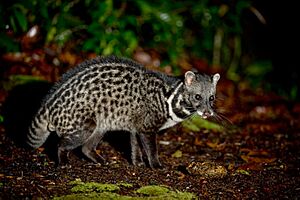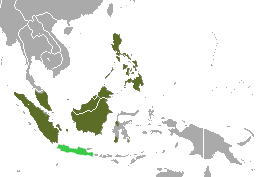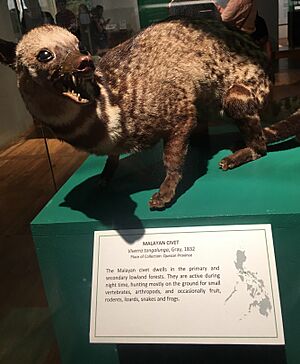Malayan civet facts for kids
Quick facts for kids Malayan civet |
|
|---|---|
 |
|
| Conservation status | |
| Scientific classification | |
| Genus: |
Viverra
|
| Species: |
tangalunga
|
 |
|
| Malayan civet range (dark green - extant, light green - probably extant) |
|
The Malayan civet (Viverra tangalunga) is also called the Malay civet or Oriental civet. It is a type of viverrid, which is a family of small to medium-sized mammals. These civets live in the Malay Peninsula and on islands like Sumatra, Bangka, Borneo, the Riau Archipelago, and the Philippines.
The Malayan civet is listed as "Least Concern" by the IUCN. This means it is not currently in danger of disappearing. It lives in many places and can handle changes to its home. It also lives in several protected areas.
Contents
What is a Malayan Civet?
The Malayan civet is a mammal with a unique look. Its scientific name, Viverra tangalunga, was given by John Edward Gray in 1832. He described it from a spotted animal specimen.
Civet Characteristics
Malayan civets have a special tail. The top part of their tail is black. The underside has rings of different colors.
Where Malayan Civets Live
Malayan civets are found in several countries. These include Indonesia, Malaysia, Brunei, the Philippines, and Singapore. In Malaysia, you can find them in Borneo and on islands like Banggi Island, Langkawi Island, and Penang Island. They also live in Peninsular Malaysia and on Sumatra.
They were also brought to Sulawesi and the Maluku Islands. Old museum records show they lived on the Indonesian islands of Java, Bawal, and Telok Pai. They were also found on the Philippine island of Leyte. In 2012, a civet was seen and photographed in Singapore.
Scientists think the civets in the Philippines might have come from Borneo. They may have naturally moved to Palawan island. After that, people might have helped them spread to other parts of the Philippines. This is because there was no land bridge between the Philippine islands during the last ice age.
Civet Habitats
Malayan civets can live in many different places. They are found in forests and areas where forests have grown back. They also live in farms and near the edges of villages.
How Malayan Civets Live
Malayan civets are usually found alone. They are omnivorous, meaning they eat both plants and animals. They mostly live on the ground.
Food and Logging
More Malayan civets live in forests that have not been logged (cut down). In these untouched forests, fruit makes up a bigger part of their diet. When forests are logged, there might be less fruit. This can lead to more competition for food. Other animals, like palm civets, eat fruit directly from trees. Malayan civets mostly find their food on the ground.
Near Bera Lake in Malaysia, Malayan civets were found in logged forests. Civets that live in trees and eat fruit are not as affected by logging. But civets that live on the ground and eat meat or insects might be harmed by logging.
Dangers to Malayan Civets
Since Malayan civets live on the ground, they can be caught in snares or traps. They are also sometimes hunted with dogs. However, studies in areas where people live show that civets can often survive these threats. People sometimes hunt them for food. They are also seen as pests because they might raid chicken coops.
In Borneo, cutting down trees for timber also harms Malayan civets.
Protecting Malayan Civets
The Malayan civet (Viverra tangalunga) is a protected animal in Malaysia. This protection comes from the Wildlife Protection Act (WPA) of 1972. However, in some rural areas of Peninsular Malaysia, people see civets as a problem. This is because civets sometimes eat small farm animals or fruit from orchards.
Section 55 of the WPA of 1972 allows farmers to shoot wild animals that damage their property. But they must first try to scare the animal away.



